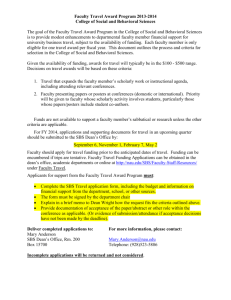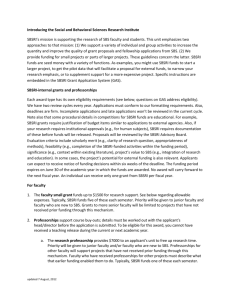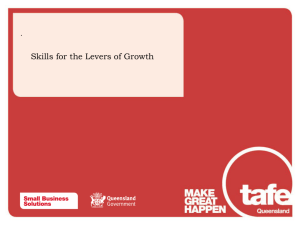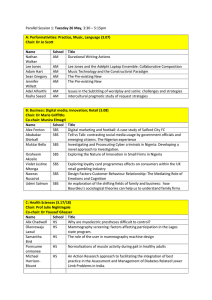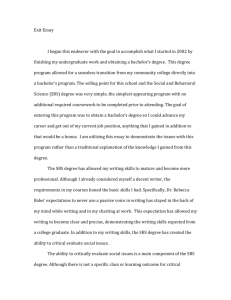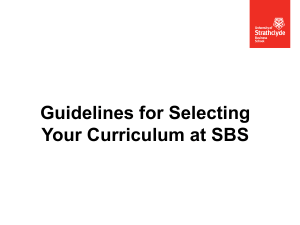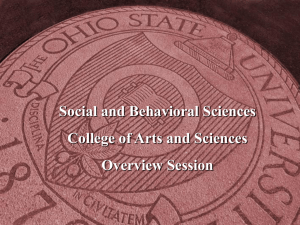SBS (Special Broadcasting Service)
advertisement
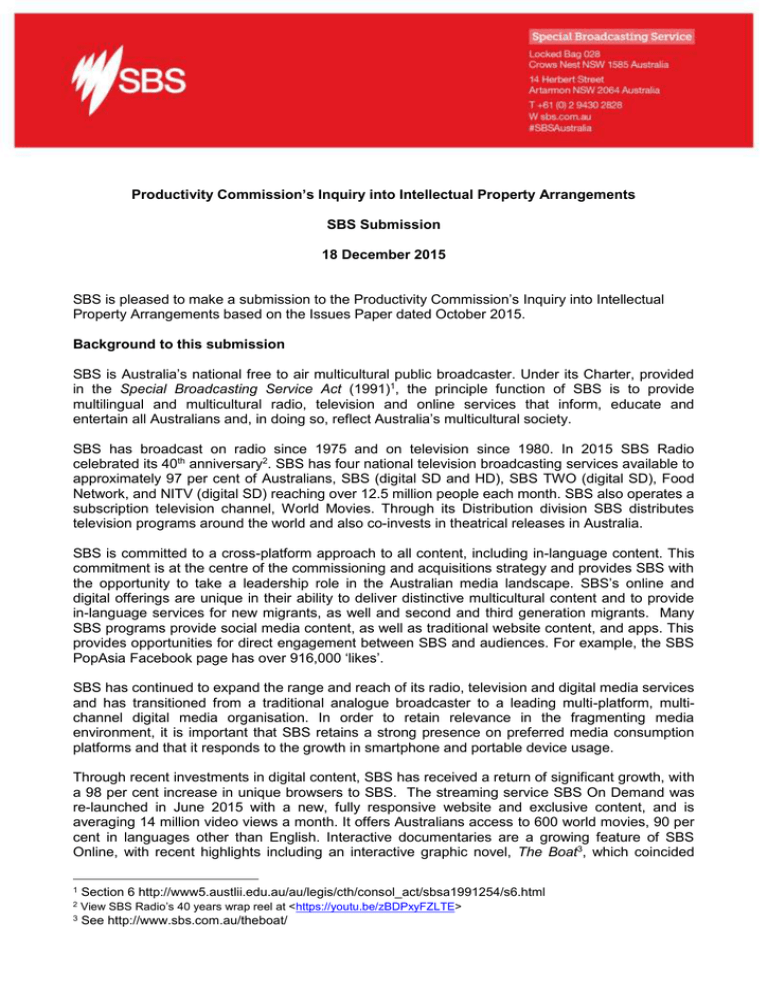
Productivity Commission’s Inquiry into Intellectual Property Arrangements SBS Submission 18 December 2015 SBS is pleased to make a submission to the Productivity Commission’s Inquiry into Intellectual Property Arrangements based on the Issues Paper dated October 2015. Background to this submission SBS is Australia’s national free to air multicultural public broadcaster. Under its Charter, provided in the Special Broadcasting Service Act (1991)1, the principle function of SBS is to provide multilingual and multicultural radio, television and online services that inform, educate and entertain all Australians and, in doing so, reflect Australia’s multicultural society. SBS has broadcast on radio since 1975 and on television since 1980. In 2015 SBS Radio celebrated its 40th anniversary2. SBS has four national television broadcasting services available to approximately 97 per cent of Australians, SBS (digital SD and HD), SBS TWO (digital SD), Food Network, and NITV (digital SD) reaching over 12.5 million people each month. SBS also operates a subscription television channel, World Movies. Through its Distribution division SBS distributes television programs around the world and also co-invests in theatrical releases in Australia. SBS is committed to a cross-platform approach to all content, including in-language content. This commitment is at the centre of the commissioning and acquisitions strategy and provides SBS with the opportunity to take a leadership role in the Australian media landscape. SBS’s online and digital offerings are unique in their ability to deliver distinctive multicultural content and to provide in-language services for new migrants, as well and second and third generation migrants. Many SBS programs provide social media content, as well as traditional website content, and apps. This provides opportunities for direct engagement between SBS and audiences. For example, the SBS PopAsia Facebook page has over 916,000 ‘likes’. SBS has continued to expand the range and reach of its radio, television and digital media services and has transitioned from a traditional analogue broadcaster to a leading multi-platform, multichannel digital media organisation. In order to retain relevance in the fragmenting media environment, it is important that SBS retains a strong presence on preferred media consumption platforms and that it responds to the growth in smartphone and portable device usage. Through recent investments in digital content, SBS has received a return of significant growth, with a 98 per cent increase in unique browsers to SBS. The streaming service SBS On Demand was re-launched in June 2015 with a new, fully responsive website and exclusive content, and is averaging 14 million video views a month. It offers Australians access to 600 world movies, 90 per cent in languages other than English. Interactive documentaries are a growing feature of SBS Online, with recent highlights including an interactive graphic novel, The Boat3, which coincided 1 Section 6 http://www5.austlii.edu.au/au/legis/cth/consol_act/sbsa1991254/s6.html 2 View SBS Radio’s 40 years wrap reel at <https://youtu.be/zBDPxyFZLTE> 3 See http://www.sbs.com.au/theboat/ with the 40th anniversary of the fall of Saigon and Vietnamese resettlement in Australia. SBS has established a Digital Creative Lab, a dedicated research and development pod to lead the strategy, user experience and technical production of a slate of innovative projects encompassing both social TV and interactive storytelling formats on the web. Their innovative work is supported by some state film agencies. SBS Radio also offers a mobile phone application, 'SBS Your Language', which gives listeners access to over 70 SBS radio language programs anytime or anywhere across all mobile service. The app allows users to live stream SBS Radio1/2/3 and Radio4, SBS PopAsia, SBS Chill, SBS PopAraby and SBS PopDesi, as well as program catch-ups with every program being available for 7-days on-demand. SBS now has around 1.2 million radio streams per month and growing. These online and digital services are engaging with audiences in large numbers. 95 per cent of SBS’s prime time television content and 100 per cent of SBS’s radio content is available online. SBS’s Charter requires it to make use of Australia’s diverse creative resources, which it does with a combination of in-house, commissioned and acquired content. Consequently, SBS is both a copyright owner and a user of copyright material under licence and through various vital copyright exceptions such as fair dealing. SBS supports a balanced copyright regime which encourages innovation and investment while also maximising public access to informative, educational and entertaining content on fair terms. SBS response to Issue Paper’s questions SBS’s submission focuses on the Copyright section of the Issues Paper. We address some critical issues relating to copyright and Australia’s economic interests below on the understanding that other key copyright issues of interest to SBS were addressed in 2012 and 2013 in its responses to the Australian Law Reform Commission’s (ALRC) Issues Paper “Copyright in the Digital Economy” (IP 42); and also to Discussion Paper 79 “Copyright and the Digital Economy” (DP 79)4. SBS would welcome the opportunity to make further comment on the Issues Paper and may wish to amend or expand its position at subsequent stages of the review, especially on the subject of fair dealing and reporting the news/sport. SBS would also be willing to engage in round table discussions or present orally as required. Summary of key copyright issues for SBS 1. 2. 3. 4. 5. Moral rights Fair dealing Copyright and contracting out Copyright and competition law International trade-in-rights 4 See SBS, Submission 237 in response to (IP 42) at <http://www.alrc.gov.au/sites/default/files/subs/237.__org_specialbroadcastingservicecorporation.pdf> dated 30 November 2012; and <http://www.alrc.gov.au/sites/default/files/subs/295._org__sbs_abc__cra_supplementary_submission_.pdf dated 23 May 2013; and SBS, Submission 556 in response to (DP 79) at <http://www.alrc.gov.au/sites/default/files/subs/556._org_sbs.pdf> dated 30 July 2013. 2 6. 7. Improving efficiencies in Australia’s copyright regime Collective administration Licensing the educational sector Music licensing Digital innovation Key Issues for SBS 1. Moral rights Moral rights underpin economic rights: recognition of the author of a work ensures respect for the integrity of the work and its ongoing attribution. Correct attribution enables efficient downstream licensing and ensures the author’s remuneration. 2. ‘Fair dealing’ v ‘Fair use’ SBS maintains its position on copyright and fair dealing as submitted to the Australian Law Reform Commission (DP 79). SBS considers that the Copyright Act 1968 (Cth) fair dealing exceptions for reporting the news, criticism and review, and parody or satire are clear and well established on all platforms and would not support any change to these provisions. Any new additional exceptions should not affect the operation of the existing ones. SBS relies strongly on fair dealing exceptions in its news reporting, including sports news reporting and other programming activities on all platforms. Fair dealing and digital sport content Media organisations are increasingly harnessing digital content to engage with audiences, particularly on social media, where audiences can interact with, comment on and share content. In the sporting rights arena, exclusive rights holders and their licensees vigorously monitor the web and social media platforms to combat copyright infringement. In Australia, fair dealing allows media organisations who are not rights holders to publish very limited footage from sporting events online in some circumstances, for example, where they are reporting the news. Australia's existing fair dealing exceptions appear less restrictive than in the US jurisdiction, where the fair use provisions effectively curtail media organisations that are non-rightsholders from reporting on sporting events. We understand from fellow broadcasters in the US that the fair use provisions of US copyright law5 for sports news reporting are not operating well because the use of sports video clips would not be covered in practice. They commented, “Stations and networks having such rights often have reciprocal agreements allowing each other use of such clips usually at some specified time after 5 Copyright Act 1976 (US) s 107 as cited in DP 79 at <https://www.alrc.gov.au/publications/4-case-fair-useaustralia/what-fair-use> 3 completion of an event”. This issue is being vigorously debated in the US6. See also the case study under ‘No contracting out of copyright exceptions’ below. Therefore, SBS cannot support the introduction of a US-based fair use system because it would be far less favourable to reporting sports news than the current fair dealing provisions under Australian copyright law. In the context of a productivity inquiry, we can advise from SBS’s direct experience that the introduction of a US-based fair use system would have a very negative impact on media organisations, significantly reducing their capacity to communicate sports programming online. However, SBS would support additional fair dealing rights which could be framed within a general fair use exception, and which may cover additional fair uses not covered within the existing exception. Such a use could include use of copyright material in the public interest where an existing provision does not apply. For example, during the recent Paris café terror attack, the incident was caught on the café’s CCTV. Although it is alleged now that the footage was obtained illegally, at the time the ‘rightsholder’ who had purchased the footage and at the same time destroyed the café’s hard disc, an international newspaper group, claimed ‘exclusivity’ and sent letters of demand for copyright infringement of this footage to some Australian television channels who had used excerpts of the CCTV footage in news stories. Our view is that if such footage is legally available, then it should be free to broadcast or communicate under a ‘public interest’ fair use exception.7 3. No contracting out of copyright exceptions SBS submits that copyright exceptions under the Copyright Act should not be overridden by contract. In many cases, it is difficult or impossible to renegotiate contractual terms in standard form contracts, especially with major international suppliers to allow fair dealings as permitted under Australian law. This disturbs the balance of copyright law intended by Parliament. This reform, if introduced, would mean for example that where SBS is a rightsholder, SBS is free to do fair dealings with licensed feeds of programs just as non-rightsholders do. Where SBS is not the rightsholder, we could make fair dealings with material which is otherwise the subject of restrictive online “click licences”. 6 < https://www.google.com.au/#q=fair+use+sports+clips>.searched 17 December 2015. “A Guide to Fair Use in Posting Soccer Video Clips” www.citizen.org/Page.aspx?pid=5391 “NFL Thinks It Gets To Decide How Long Is Fair Use For ...” https://www.techdirt.com/articles/20070702/034646.shtml “Sports video clips are now ubiquitous on social media. Can ...” https://www.washingtonpost.com/sports/sports...clips.../e986f34c-71c9-11e... 7 http://www.ledauphine.com/france-monde/2015/11/20/video-les-images-de-la-fusillade-depuis-l-interieur-dun-restaurant; http://m.canalplus.fr/?vid=1333533; ”Daily Mail accused of paying Euro50,000 for CCTV video of Paris attack” http://www.theguardian.com/media/2015/nov/24/daily-mail-cctv-video-paris-attack 4 Case study: Fair dealing and digital sport content SBS Sport posts very short clips from sporting matches on its social platforms in the course of reporting the news. A news summary appears alongside the footage or the footage is overlaid with voiced news commentary. On three separate occasions in 2015, SBS was contacted by agents acting for rightsholders who alleged such clips did not fall within the fair dealing exceptions and requested removal of the clips (or contacted Facebook directly alleging infringement). While media organisations are increasingly using social media platforms to disseminate news, platforms such as Facebook may act to remove or disable access to content posted on the platform when a third party alleges copyright infringement. It is up to the media organisation and the third party to resolve any complaints between themselves (and a party may apply for a review). Therefore, where a rightsholder alleges infringement, even where the material may arguably fall within the fair dealing exceptions, the content may have already been removed by Facebook, and any fair dealing argument would need to be resolved after the fact between the parties. The time taken to resolve the matter means the newsworthiness and timeliness of the footage would be reduced and the fair dealing argument affected. In addition, once this process occurs repeatedly, Facebook may disable the account upon which the allegedly infringing material is posted. The risk of jeopardising a brand's Facebook page with a significant audience reach means that in practical terms, the ability for media organisations to report sports news fully and fairly is stifled. According to The Washington Post, ‘In a recent decision in the U.S. Court of Appeals for the Ninth Circuit, a three-judge panel said that copyright holders “must consider the existence of fair use before sending a takedown notification.”8 Legal analysts say this could expand the interpretation of fair use and force leagues to think twice before filing a complaint.'9 Anecdotally other media organisations, including The Guardian, have also commented that their dealings with social media organisations or internet services like Google to have material that has been arbitrarily removed from their sites via standard appeal routes have elicited a ‘banal’ response and are effectively creating censorship. In SBS’s view this long overdue reform to the Copyright Act will create certainty and a level playing field in relation to use of copyright material in the public interest. 4. Copyright and competition law Copyright is a natural monopoly. SBS agrees with the ALRC (DP 79) that, ‘Copyright law and competition law are largely complementary in that both seek to promote innovation, higher living standards, and expand the choices and benefits to society.’ 8 Lenz v Universal Music Corp, see http://cdn.ca9.uscourts.gov/datastore/opinions/2015/09/14/13-16106.pdf At <https://www.washingtonpost.com/sports/sports-video-clips-are-now-ubiquitous-on-social-media-canthe-nfl-put-the-genie-back-in-the-bottle/2015/10/13/e986f34c-71c9-11e5-8248-98e0f5a2e830_story.html.> search 17 December 2015. 9 5 In Australia, competition law is regulated by the Competition and Consumer Act 2010 (Cth) and the ACCC.10 In SBS’s experience the ACCC’s authorisation process has been impartial, efficient and effective. For example: The ACCC grants an authorisation to the Australasian Performing Right Association Ltd (APRA) for its arrangements for the acquisition and licensing of performing rights in music. During the APRA re-authorisation process, SBS was given timely notice and the opportunity to voice its concerns, if any, by making submissions and/or participating in meetings.11 From a user’s perspective, we believe the re-authorisation process is working efficiently to the benefit of rights owners and users (broadcasters). Our understanding is that it also gives rights owners an opportunity to ‘opt-out’ of their agreement with APRA and exercise their rights directly if they wish to do so. However, to date SBS has not received a request from an APRA member to opt out of the blanket music broadcast or communication licences. 5. International Trade-in-Rights USFTA Term of copyright: As a result of the introduction of the USFTA, the term of copyright in Australia was extended to life plus 70 years. This extension of term also aligns Australia with its other key international IP trading partners in Europe and the UK amongst others. Copyright is easier to administer if there is international harmonisation of laws. To date SBS has not experienced any negative impact on our use and/or cost of licensing copyright material from the extension of term. For instance: SBS focuses on acquiring contemporary film and television material and it would be extremely rare for us to acquire classic films. The value of sports rights is market-driven. Our key music blanket copyright licences for the right to broadcast music uses a methodology calculated on a percentage of revenue basis, not according to each individual title in copyright that we use. In SBS’s experience, the issue of the duration of copyright is intrinsically related to the treatment of orphan works, so please refer to point 8 below. 6. Improving efficiencies in Australia’s copyright regime Administration of copyright Copyright and the Digital Economy, (ALRC Report 122), Chapter 3 ‘Copyright Reform in Context: Competition issues and copyright reform’, 3.80 – 3.98. 11 http://apraamcos.com.au/media/3438/2014finaldetermination.pdf 10 6 Role of collecting societies SBS strongly supports the purpose and work of Australian collecting societies and their international network of business partners. As a member of CAL and Screenrights, we benefit financially from the collective management of our statutory rights nationally and internationally. As a licensee of musical works and sound recordings, the efficient administration of music rights via AMCOS/APRA and ARIA/PPCA blanket licences that cover an international repertoire is critical to our broadcast and growing online business. Licensing the educational sector As stated above, SBS strongly supports the retention of the current fair dealing regime in Australia. In relation to the statutory licences, SBS would support APRA/AMCOS, Copyright Agency and Viscopy’s proposal to streamline educational statutory licences to be more efficient than the current arrangements. Music licensing for broadcasters In relation to music ‘blanket’ licences, SBS has a number of music blanket licences for a range of different rights from the owners of musical works and/or sound recordings. ln the increasingly fragmented market for digital rights, the rights granted to SBS by their representative collecting societies do not necessarily ‘match up’ with one another. We understand that these societies can only administer the rights they have been assigned or granted by rights owners, such as record companies. However, we would welcome a similar initiative to the one proposed for the educational sector for the broadcast industry so that the music collecting societies, AMCOS/APRA and ARIA/PPCA, could provide a combined ‘one-stop shop’ to license music rights (including a streamlined and centralised reporting system) for broadcast and communication. Copyright Hub How effective are new approaches, such as the United Kingdom’s Copyright Hub in enabling value realisation to copyright holders? In accordance with Copyright Agency and Viscopy’s Submission to the Commission12, we also note that the Copyright Hub’s scheme is only in its infancy. However, extended collective licensing has worked very well in the Nordic countries. We see value for users like SBS, who require large volumes of content at affordable rates, in centralising transactional licensing to complement statutory licensing. 7. Digital innovation SBS Digital’s Creative Lab is producing content in a 360° environment that will be viewed on commercial platforms. As a 360° content producer for innovative platforms, SBS uses a mix of commissioned and acquired material and we rely on various copyright exceptions such as fair dealing. Since SBS films a lot of this material, including events in public places, it would be helpful to simplify the exceptions that apply to incidental filming, broadcasting and communication. 12 Copyright Agency/ Viscopy, Submission 47, p 17. 7 In the digital world it is impractical to expect broadcasters who live stream events and/or individual members of the general public to be able to instantaneously license and/or edit the recording from their live posts. Otherwise, SBS’s Digital Creative Lab depends upon ensuring that we can attract the investment to build our infrastructure because we can ‘pump out the content’ to a multitude of platforms. 8. Other issues Other key copyright issues of interest to SBS were addressed last year in our response to ALRC 79, including on the subjects of archives and orphan works; and also the retransmission of free to air broadcasts. We are prepared to make further submissions on these topics if requested by the Commission. 8

